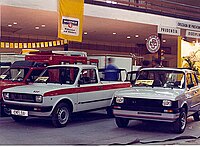
The Fiat 128 is a transverse front-engine, front wheel drive small family car manufactured and marketed by Fiat from 1969 to 1985 as a two- or four-door sedan, three- or five-door station wagon as well as two- or three-door coupé. The 128 running gear and engine, reconfigured for a mid-engined layout, were used in the Fiat X1/9 sports car.

The Citroën Visa is a five-door, front-engine, front wheel drive supermini manufactured and marketed by Citroën from 1978 to 1988 in gasoline and diesel variants. 1,254,390 examples were ultimately manufactured over a single generation, with a single facelift (1981). China has also assembled the car as the Liuzhou Wuling LZW 7100 minicar. Production started in 1991 and finished in 1994.

The Fiat 127 is a supermini car produced by Italian car manufacturer Fiat from 1971 to 1983. It was introduced in 1971 as the replacement for the Fiat 850. Production of the 127 in Italy ended in 1983 following the introduction of its replacement, the Fiat Uno, although the nameplate continued to be used on cars imported from Brazil.

The Fiat Uno is a supermini manufactured and marketed by Fiat. Launched in 1983, the Uno was produced over a single generation in three and five-door hatchback body styles until 1995 in Europe — and until 1 January 2014, in Brazil. Designed by Giorgetto Giugiaro of Italdesign, the Uno strongly recalled the high-roof, up-right packaging of Giugiaro's 1978 Lancia Megagamma concept, in a smaller configuration.
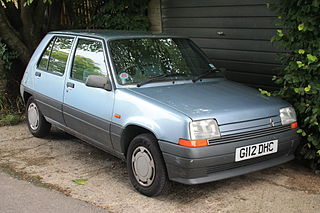
The Renault 5 is a five-passenger, three or five-door, front-engine, front-wheel drive hatchback supermini manufactured and marketed by the French automaker Renault over two generations: 1972–1985 and 1984–1996.

The Peugeot 104 is a supermini car produced by the French company Peugeot between 1972 and 1988. It was designed by Paolo Martin was initially only sold as a four-door saloon car, with a three-door hatchback variant introduced in 1974 and a five-door hatchback version replacing the saloon in 1976. The 104 was the first model produced at the company's Mulhouse plant. It was also the first new Peugeot introduced since 1955 not to be offered in a diesel version.

The Opel Ascona is a large family car that was produced by the German automaker Opel from 1970 to 1988. It was produced in three separate generations, beginning with rear-wheel-drive and ending up as a front-wheel drive J-car derivative. The Ascona was developed to fill the gap in the Opel range as the Opel Rekord was gradually growing in size.
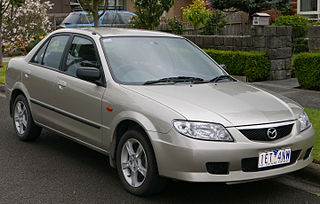
The Mazda Familia, also marketed prominently as the Mazda 323, Mazda Protegé and Mazda Allegro, is a small family car that was manufactured by Mazda between 1963 and 2003. The Familia line was replaced by the Mazda3/Axela for 2004.
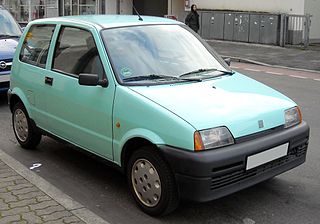
The Fiat Cinquecento is a front engine front-wheel-drive, four passenger, three door hatchback city car manufactured and marketed by Fiat from 1991 to 1998 over a single generation. It was manufactured at Fiat Auto Poland, which had manufactured its predecessor the Fiat 126.

The Fiat Ritmo is a small, front-engine, front-wheel drive family car manufactured and marketed by Fiat, launched in April 1978 at the Turin Motor show and offered in 3- and 5-door hatchback and cabriolet body styles – from 1978 to 1988 with two facelifts.

The Nissan Pulsar is a line of automobiles produced by the Japanese automaker Nissan from 1978 until 2000, when it was replaced by the Nissan Bluebird Sylphy in the Japanese market.

The Fiat 131 is a mid-size family car manufactured and marketed by Fiat from 1974 to 1984 after its debut at the 1974 Turin Motor Show. Available as a two-door and four-door saloon and 5-door estate across a single generation, the 131 succeeded the Fiat 124.

The Fiat 600 is a small, rear-engined city car and economy family car made by Italian carmaker Fiat from 1955 to 1969 — offered in two-door fastback sedan and four-door Multipla mini MPV body styles. The 600 is considered a pop icon of the Italian economic miracle, and the three-row seating Multipla, though diminutive and odd-looking, is seen as one the first mass-produced minivans.

The Fiat 147 was a three-door hatchback subcompact car produced by Fiat in the Brazilian state of Minas Gerais from autumn 1976 until 1987, when it was replaced by the Fiat Uno. It was the Brazilian variant of the Fiat 127. Some were also built by Sevel in Argentina until 1996, and assembly also took place in Colombia, Uruguay and Venezuela.
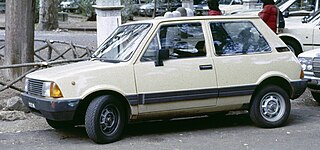
The Innocenti Mini is an automobile introduced by Innocenti in 1974. The vehicle was a rebodied, three-door hatchback version of the Mini, styled by Bertone. A five-door prototype was developed around 1980, but was never put into production. After having been sold to De Tomaso in 1976, the Innocenti Mini ended up being powered by Daihatsu-sourced three-cylinder engines and continued in production in incrementally updated forms until 1993.

The FSO Polonez is a motor vehicle that was developed in Poland in collaboration with Fiat and produced by Fabryka Samochodów Osobowych from 1978 to 2002. It was based on the Polski Fiat 125p platform with a new hatchback design by Zbigniew Watson, Walter de Silva and Giorgetto Giugiaro. It was available in body styles that included two- and four-door compact-sized cars, station wagons, as well as commercial versions as pickup truck, cargo van, and ambulance. Production totaled more than one million units, excluding the pickup truck and van variants. The Polonez was marketed in other nations and was popular in its domestic market until Poland joined the European Union in 2004.

The Simca 1100 is a series of French compact family cars – mainly C-segment hatchbacks, but also a compact wagon and popular delivery vans – built for over 15 years by French car-maker Simca, from 1967 through 1982/1985. There was even a very early 'hot hatchback', and a family cross-over: the Matra Simca Rancho. The hatchbacks were replaced by the Simca-Talbot Horizon.

The Autobianchi A112 is a supermini produced by the Italian automaker Autobianchi. It was developed using a shrunken version of the contemporary Fiat 128's platform. The mechanicals of the A112 subsequently underpinned the Fiat 127. It was introduced in November 1969, as a replacement for the Bianchina and Primula, and was built until 1986, when it made way for the more modern Autobianchi Y10. Over 1.2 million A112s were produced in Autobianchi's Milan factory.

The Lancia Gamma, stylised as Lancia γ, is an executive car manufactured and marketed by the Lancia subdivision of Fiat. Following its debut at the 1976 Geneva Motor Show as Lancia's new flagship, the Gamma was marketed as a 4-door fastback saloon known as the Berlina (1976–1984) and as a 2-door coupé (1977–1984), both designed by Pininfarina – with 15,272 and 6,790 manufactured, respectively. The Gamma superseded the Lancia 2000.
Sipani Automobiles Ltd. was an Indian car manufacturer established in 1973, located in Bangalore. They mainly manufactured subcompact cars with fibreglass bodies. They also took over Auto Tractors Limited in 1991 and manufactured diesel engines and tractors in the old ATL factory in Pratapgarh, Uttar Pradesh.






